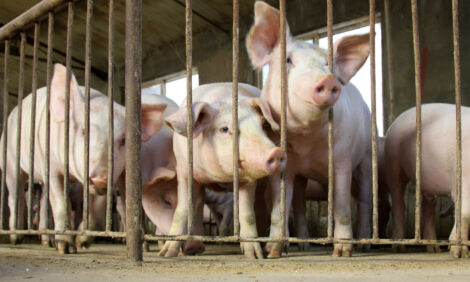



Russia: Hog Markets
RUSSIA - The Russian market is still being rocked, almost on a weekly basis by new outbreaks of ASF. Just this week two more regions in Russia has been found in both the Bryansk and Tula oblasts, writes Susan Wulf, Managing Director of Genesus Life Science.Authorities believe that the outbreak in Bryansk was actually brought in from the Tula region, from animals going to market. Additionally, in the Moskovskaya region, a wild boar was found to be infected with the disease.
This disease has been in Russia since 2007, with 2013 being the worst year thus far for outbreaks. Farms have been subjected to quarantines, inspections, movement control and high levels of security to obtain a Level 4 biosecurity status and to remain in business in Russia. Overall losses in Russia due to the disease has surpassed $1 billion dollars.
Just last week, in an attempt to prevent any more spread of ASF from abroad, Russia has banned all pork imports from the EU, after a confirmed report in Lithuania. Authorities speculate that this ban on EU imports could be lifted in approximately three months, but expect the ban on pork imports from other countries, specifically those in the Baltic region, could continue for three years, due to the number of ASF outbreaks they have experienced.
This ban on imports into Russia from the EU will affect about 25 per cent of their pork exports. Not a major amount, but in the Russian market, it represents approximately 55 per cent of the imported pork. Expect pork prices to increase here in Russia for the consumer, as well as other protein sources that are available.
2013 saw an actual increase in pork production in Russia, as was recently reported. The number of pigs was 10.8 million, an increase of 2.3 per cent than 2012. This increase was in the production sector, with an increase there of 7.2 per cent (a bit over a million) with a significant decrease (12 per cent) in backyard pigs. This resulted in 18.2 per cent more domestic meat going to market in Russia. This amount, while significant, is not enough to offset the 55 per cent of the imported pork into Russia.
One of the promising signs on the horizon for Russia and EU is that the Russian Research Institute, in a joint effort with the University of Illinois (Champaign, IL, USA) has developed a vaccine against African Swine Fever, and initial trials show success is stemming the virus. Now, additional trials have to be run to ensure that the treated animals cannot spread the disease to others. Researchers expect that if the subsequent tests and trials are as successful as the first ones, they will be able to start using the vaccine commercially in 2016.
So what happens in the meantime? Diligence on the part of every pork producer. Continued high level biosecurity, restricted animal movement, bans on imports and, unfortunately, entire herd destruction when a farm or region is affected.
And, if that isn’t enough, Foot and Mouth Disease (FMD) was found in Russia in January, in the Zabajkal'skij krai. While no pigs were affected by the disease, over 1200 were found to be “susceptible” to the disease and a close eye will be kept on them and the region to see if there are further outbreaks. Another thing that we need to keep close tabs on as producers in Russia.
All of this will place a higher demand on domestic pork products and a corresponding increase in price, as well as on other meat products in the marketplace. How much? Some industry experts expect a 10 per cent to 20 per cent increase on pork that averages about 300 rubles a kilogram ($4/lb). This is in a region where almost 40 per cent of disposable income goes toward food.
Definitely this increase will be felt at the markets. While the 18.3 per cent increase from 2012 to 2013 will definitely help to offset the deficit that the EU ban will create, Russian pork producers will need to tighten up management practices in order to make up the balance (36.7 per cent) in order to keep per capita consumption at 22 kg.
We will continue to keep a close eye on what is happening, both with ASF and FMD, and subsequent actions and how it all affects pork production here in Russia as well as the impact on the EU.
This week we are attending AgroFarm in Moscow, the one of largest agricultural trades show in Russia. There are over 370 exhibitors here from 29 different countries. While the scope of the show is of animal breeding and husbandry, the porcine sector has grown significantly such that a second exhibit hall had to be opened to house the exhibitors.
Discussions of course are about ASF, but also on new technologies and how they can impact the human factor (reduce redundancy and labor force) in the barns here in Russia. Attendance this year is better than last year, with good weather playing a significant role.
| Genesus Global Market Report Prices for the week of January 27, 2013 | ||
|---|---|---|
| Country | Domestic price (own currency) | US dollars (Liveweight a lb) |
| USA (Iowa-Minnesota) | 82.47 USD/lb carcass | 61.03¢ |
| Canada (Ontario) | 164.95 CAD/kg carcass | 53.92¢ |
| Mexico (DF) | 26.6 MXN/kg liveweight | 90.46¢ |
| Brazil (South Region) | 3.64 BRL/kg liveweight | 68.86¢ |
| Russia | 72 RUB/kg liveweight | 93.59¢ |
| China | 12.46 RMB/kg liveweight | 93.27¢ |
| Spain | 1.227 EUR/kg liveweight | 75.26¢ |
| Viet Nam | 48,000 VND/kg liveweight | $1.03 |
| South Korea | 3,379 KRW/kg liveweight | $1.42 |








